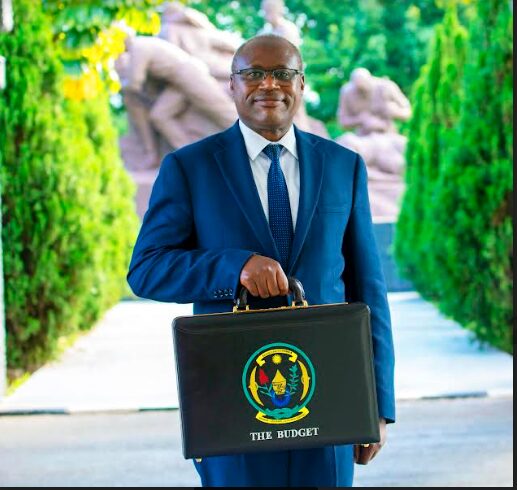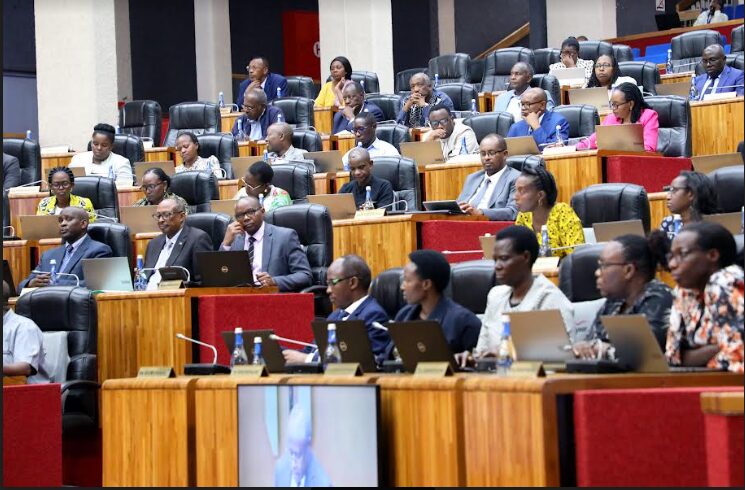
Min. Uzziel Ndagijimana
Rwanda Parliament has approved a proposed budget for the Fiscal Year (FY) 2024/2025 that is forecasted at Rwf5,690.1 billion in estimated resources that will focus on sustainable economic development, improved social welfare and climate change mitigation.
The budget which has a 11.2% increase (Rwf574.5 billion) from the revised budget for the fiscal year 2023/24 was re-tabled this May 24, 2024 to both Houses of Parliament by Finance Minister, Uzziel Ndagijimana.
The budget comprises domestic revenues of Rwf3,414.4 billion, with Rwf2,970.4 billion expected from tax revenues and Rwf444.0 billion from other revenues but also anticipates additional Rwf231.5 billion for equity, investment fund shares, and policy lending.
Projected Economic Performance
The Minister showed that the global economy (GDP) grew at 3.2% in 2023 and is expected to remain at the same growth rate for the next FY 2024/2025 while in Rwanda the GDP grew 8.2% (above the 6.2% projected) driven by industry and services sector.
Ndagijimana said that Rwanda is expected to see a GDP growth of 6.6% in 2024 and by 6.5% (in 2025), 6.8% (in 2026 and 7.2% in 2027.
In this year 2024, Agriculture will grow by 5% compared to 1.7% in 2023; Industry will grow by 8.9% compared to 10.2%; Service will grow slower by 6.8% compared to 11.2% and market prices are expected to increase by 5% against 14% in the same period.
The balance of trade (trade gap) increased 19.1% to $2.36 8billion from $1.988billion in 2022.
Despite this, Ndagijimana showed that the country’s debt burden was under control and well managed, below all debt cap standards as measured by any global standard.
The implementation budget year 2023-24 has Rwf5,030billion and revised from Rwf5,115.6billion and so far over Rwf2,000billion has been solicited compared to the over Rwf3,000billion expected as of May 2024.
This has seen some achievement, among others, which include: over 764, 000-hectare arable land prepared for planting food crops (beans maize, cassava, rice and Irish potatoes and vegetables) compared to over783, 000 ha planned and over 26,000 ha insured.’

Parliamentarians following the budget speech
Futhernore in Agriculture, at least 50,000 cows were inseminated; and livestock insurance covered close to 32, 000 cows, 214,000 chicken and 8,000 pigs. This saw over 29,000 litres of milk proceed and increased crop exports (worth over $147million).
Meanwhile, the main grid this year connected another 78,000 homes, and 393 institutions while 167,000 other homes were connected to solar power.
Tight Policy and Strategies
In order to speed up and implement the 7- year National Strategy for Transformation (NST1) which ends this year, Ndagijimana showed the key priorities in this year’s budget.
Rwanda will focus on reducing the budget dependence, debt management and absorb global shocks caused by conflict, climate change and fluctuating market prices.
“This will see the increase in domestic revenues by revising taxation laws- which is already done and more to be done, but also improve tax collection using technology and reward EBM (Electronic Billing Machine) users,” Ndagijimana said.
On budget funding gaps, the Minister said that the plan is to reduce this from 6.7% of GDP in 2023 to 5.2% next fiscal year and reach 3.1% by 2026/2027.
Ndagijimana revealed that the national total debt reached 73.5% of GDP in 2023 and is expected to increase to 78% in 2024 before going down to 73.9 in 2027.
“This will require cutting expenditures on some activities which are not urgent or which can be done in inexpensive ways, for example reducing the number of meetings and on duty travels and using more technology,” he said.
Ndagijimana revealed that key activities will be implemented in line with NST1 and speed up partner funded projects but also presidential pledges and commitments made during national meetings.

